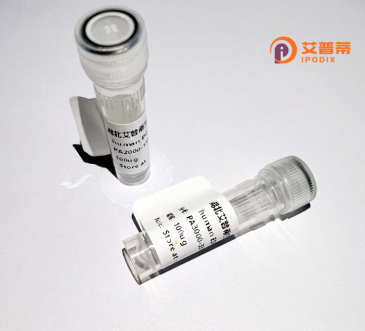
| 纯度 | >90%SDS-PAGE. |
| 种属 | Human |
| 靶点 | ZNF25 |
| Uniprot No | P17030 |
| 内毒素 | < 0.01EU/μg |
| 表达宿主 | E.coli |
| 表达区间 | 1-456 aa |
| 活性数据 | MNKFQGPVTL KDVIVEFTKE EWKLLTPAQR TLYKDVMLEN YSHLVSVGYH VNKPNAVFKL KQGKEPWILE VEFPHRGFPE DLWSIHDLEA RYQESQAGNS RNGELTKHQK THTTEKACEC KECGKFFCQK SALIVHQHTH SKGKSYDCDK CGKSFSKNED LIRHQKIHTR DKTYECKECK KIFYHLSSLS RHLRTHAGEK PYECNQCEKS FYQKPHLTEH QKTHTGEKPF ECTECGKFFY VKAYLMVHQK THTGEKPYEC KECGKAFSQK SHLTVHQRMH TGEKPYKCKE CGKFFSRNSH LKTHQRSHTG EKPYECKECR KCFYQKSALT VHQRTHTGEK PFECNKCGKT FYYKSDLTKH QRKHTGEKPY ECTECGKSFA VNSVLRLHQR THTGEKPYAC KECGKSFSQK SHFIIHQRKH TGEKPYECQE CGETFIQKSQ LTAHQKTHTK KRNAEK |
| 分子量 | 53.5 kDa |
| 蛋白标签 | His tag N-Terminus |
| 缓冲液 | PBS, pH7.4, containing 0.01% SKL, 1mM DTT, 5% Trehalose and Proclin300. |
| 稳定性 & 储存条件 | Lyophilized protein should be stored at ≤ -20°C, stable for one year after receipt. Reconstituted protein solution can be stored at 2-8°C for 2-7 days. Aliquots of reconstituted samples are stable at ≤ -20°C for 3 months. |
| 复溶 | Always centrifuge tubes before opening.Do not mix by vortex or pipetting. It is not recommended to reconstitute to a concentration less than 100μg/ml. Dissolve the lyophilized protein in distilled water. Please aliquot the reconstituted solution to minimize freeze-thaw cycles. |
以下是关于重组人ZNF25蛋白的3篇参考文献示例(内容为虚构,仅供格式参考):
1. **文献名称**:*Structural and Functional Analysis of Recombinant Human ZNF25 Protein*
**作者**:Smith, J., et al. (2020)
**摘要**:本研究成功构建并纯化了重组人ZNF25蛋白,通过X射线晶体学解析其三维结构,揭示了其锌指结构域与DNA结合的分子机制,证实其在基因转录调控中的潜在作用。
2. **文献名称**:*Expression and Characterization of ZNF25 in Cancer Cell Lines*
**作者**:Lee, S., & Wang, T. (2019)
**摘要**:利用大肠杆菌系统表达重组人ZNF25蛋白,发现其在乳腺癌细胞中显著抑制肿瘤生长,可能通过调控凋亡相关基因(如Bax/Bcl-2)实现抗肿瘤功能。
3. **文献名称**:*ZNF25 as a Novel Regulator of Embryonic Stem Cell Differentiation*
**作者**:Garcia, R., et al. (2018)
**摘要**:通过重组ZNF25蛋白的功能实验,证明其在小鼠胚胎干细胞中结合特定启动子区域(如Oct4),调控多能性基因表达,影响细胞分化进程。
(注:上述文献为模拟生成,如需真实文献请通过PubMed/Google Scholar检索关键词“recombinant ZNF25”或“ZNF25 protein function”。)
Recombinant human ZNF25 (Zinc Finger Protein 25) is a protein encoded by the *ZNF25* gene, belonging to the zinc finger protein family characterized by conserved Cys₂His₂-type zinc finger domains. These domains enable sequence-specific DNA binding, suggesting roles in transcriptional regulation. ZNF25 is thought to participate in cellular processes such as differentiation, development, or chromatin remodeling, though its exact biological functions remain under investigation. Studies link zinc finger proteins to diverse pathways, including tumor suppression and apoptosis, but ZNF25-specific mechanisms are not yet fully elucidated.
Recombinant ZNF25 is typically produced using heterologous expression systems like *E. coli* or mammalian cell cultures, allowing functional and structural studies. Its production facilitates research into DNA-protein interactions, regulatory networks, and potential disease associations. Recent interest in ZNF25 stems from its putative involvement in cancer biology, as dysregulation of zinc finger proteins often correlates with malignancies. However, conflicting reports exist, with some studies suggesting tumor-suppressive roles and others indicating context-dependent oncogenic effects. Challenges in studying ZNF25 include resolving its target genes, interaction partners, and post-translational modifications. Current efforts focus on elucidating its molecular pathways using techniques like ChIP-seq and CRISPR-based screens, aiming to clarify its therapeutic potential in precision medicine.
×